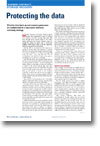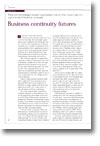
Protecting the data
- Article 1 of 2
- Business Continuity, March 2004
Effective data back up and recovery processes are fundamental to a successful business continuity strategy.
Page 1 | Page 2 | Page 3 | All 3 Pages
Modern business continuity thinking rightly stresses that organisations need to protect their business processes, not just their data. But even though every second counts in the online world, processes are mostly transient, and can usually be picked up again after a continuity problem. When data is lost, it can be expensive, embarrassing and even devastating.
Ask the CEO of Co-Operators Life Insurance in Canada. In January 2003, the company's IT partner, IBM, informed it that it had mislaid the financial details of as many as 180,000 of its clients. Eventually IBM found the data - but only after the CEO of Co-Operators Life, fearful of large losses, gave a humiliating press conference to apologise.
Until the mid-1990s, the mainstay of data back up was tape. Even today, many smaller companies use tape as a primary back-up medium - because it is cheap and reliable. If there is a disk failure, however, IT staff have to search for the correct back-up tape, then spool through the tape to locate the wanted data. This takes time. And while modern tape drives may be able to back up and restore as much as two terabytes (2,000GB) of data in less than an hour, according to Graham Hunt, product marketing manager, EMEA, at storage specialist Quantum, this is far slower than disk-to-disk copying.
Tape is prone to other problems, too. “If one file is missing, it affects the whole recovery,” says Tony Reid, director of enterprise systems for HDS EMEA.
For these reasons tape now takes second place to disk-based back-up systems, and is reserved for archiving and offline restores only. Most organisations choose to use direct copying from one disk to another local drive as their primary business continuity back up, providing the maximum possible speed for both back up and restore. “It's very fast” says Tarek Maliti, technical director of hosting company TDM. “You can choose which files you want, point to the version and it's restored in seconds.”
A disk-based back up can also be organised at several levels, says Laurence James, disk business manager at Storagetek: at an application or operating system level, with either writing to both drives simultaneously; at an intermediate level, where a software or hardware agent monitors a server for disk writes and replicates them on the back-up drive; or at disk controller level, where any instructions to write to disk are duplicated by the hardware to replicate the write on the second disk. Batch back-ups, which tend to be out of date quickly, are effectively replaced.
The software-based approach is used by a number of software companies, including NeverFail, a Microsoft specialist. NeverFail sells software agents that monitor both SQL Server and Exchange Server and replicate their contents on a second server. The higher level of the software agent means it may not be as fast as the pure hardware approach, but it can integrate into systems management tools. It can also access hardware information from the operating system and can use this to anticipate a hardware failure and initiate a switchover to a second server. It can also get a more complete view of the disk's situation.
“There is a perception that a tape back-up or traditional disaster recovery will help in the event of disaster,” says Steve Stobo, European sales and marketing director at NeverFail. “But when Exchange Server goes down, it usually goes down quite messily - usually for a day or so.” Stobo says NeverFail for Exchange Server can spot problems and switch the servers before the data is corrupted.
Remote management
These strategies are all effective for dealing with the common problem of a local drive failure. But what if the business interruption stems from something more than a single sub-system problem - such as a flood or fire?
Only a remote back-up system can deal with this. In the event of a breakdown of the primary centre, the second centre can pick up the slack with a complete or near-complete copy of the original data.
Page 1 | Page 2 | Page 3 | All 3 Pages

